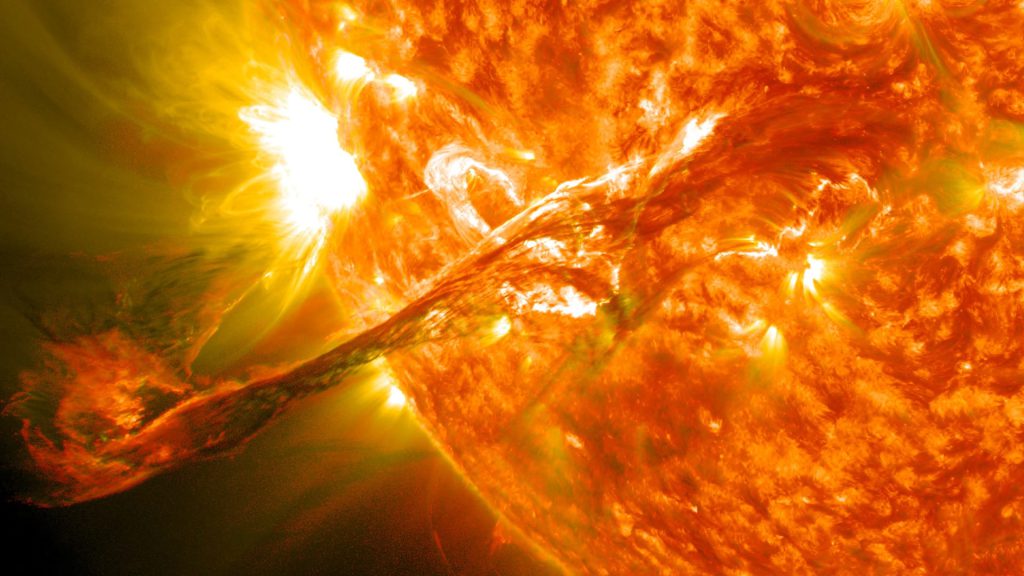
Solar Storms: Threat or Non-Event?
Originally Published on: Oct 04, 2016; Updated Over the Years with the Latest Update Done in Aug 2023
The sun, a constant presence in our lives, occasionally reminds us of its immense power through events known as solar storms. These storms, characterized by eruptions from the sun’s surface and the release of charged particles, have been part of Earth’s history for centuries. However, the way they impact our world has evolved dramatically, driven by our growing dependence on technology. This article delves into the intriguing world of solar storms, from historical events like the 1859 Carrington Event to more recent near-misses and their implications for our modern, interconnected society.
The 1859 Carrington Event
The Carrington Event of 1859 was a significant solar storm that had a profound impact on telegraph systems across Europe and North America. The event occurred when British astronomers Richard Carrington and Richard Hodgson observed a massive solar flare erupting from the sun, followed by a coronal mass ejection (CME) directed towards Earth. Two days later, the CME arrived, causing strong geomagnetic storms and one of the largest auroral displays ever recorded. Telegraph systems experienced outages, and some operators even received electric shocks from their equipment. If a similar event were to occur today, the consequences could be catastrophic, with region-wide blackouts and potential damage to electrical power grids, leaving billions without power for months or even years.
To mitigate risks, utilities can install blocking devices to prevent geomagnetically induced currents from entering the power grid. Satellites and astronauts can be shielded with additional protective materials. Governments, scientists and engineers must collaborate to improve space weather monitoring and early warning systems. The public should also be educated on the potential impacts of solar storms and the need for preparedness. By taking proactive steps now, we can reduce the likelihood of severe disruptions to critical infrastructure during future solar events.
The 1921 Railroad Storm
In May 1921, another powerful solar storm, known as the Railroad Storm, caused significant disruptions to the power grid and communication systems along the northeast coast of the United States. The geomagnetic storm produced surges in ground currents that overloaded and destroyed transformers, leading to the shutdown of telegraph systems and the halting of New York City’s subway system. The impacts of this storm were significant at the time, but if a similar event were to occur today, the damage to modern power grids and the disruption of communications could be far more severe. The increased reliance on technology and interconnected systems makes us more vulnerable to the effects of solar storms.
The 1989 Hydro-Québec Blackout
On March 13, 1989, a severe geomagnetic storm caused by two consecutive solar coronal mass ejections struck the Earth, resulting in a region-wide blackout in Quebec, Canada. The solar storms induced currents in the Hydro-Québec power grid, overloading transformers and causing widespread power outages that lasted for over nine hours. This event affected over six million people and serves as a reminder of the potential damage a more powerful solar storm could cause today. With our increased reliance on technology and interconnected grids, a similar event could have even more significant consequences, affecting multiple regions and potentially leading to prolonged power outages.
Growing Risks in the Modern Era
While historical solar storms provide examples of potential impacts, the risks to our highly technological world have grown enormously in recent decades. Our dependence on satellites for various purposes, such as GPS, communications, banking, air travel, weather monitoring, and military applications, has increased significantly. A major solar storm could result in radiation damage and orbital decay, potentially knocking out over 50% of operational satellites. On the ground, solar storms induce surges in currents that flow through power grids and pipelines, leading to transformer damage, power outages, and accelerated corrosion in oil and gas pipelines. These vulnerabilities highlight the urgent need to prioritize measures such as grid hardening, backup power solutions, and satellite shielding to safeguard our technological civilization.
Recent Near-Misses
Solar storms pose a significant threat to critical infrastructure on Earth. Solar flares and coronal mass ejections can trigger geomagnetic storms that induce strong electric currents in power grids, pipelines, and other conductive systems. This can lead to widespread blackouts, damage to transformers, and disruptions to satellite communications and GPS services. Recent solar cycles indicate that severe space weather events are likely to occur more frequently as the sun reaches a period of increased activity over the next few years.
In recent years, there have been instances of powerful solar storms that narrowly missed Earth, but could have had significant impacts if their trajectories were slightly different. For example, in August 2010, a series of X-class solar flares and coronal mass ejections occurred, which could have resulted in major geomagnetic storms if they were Earth-directed. Similarly, in July 2012, a massive solar filament eruption had the potential to cause one of the most damaging solar radiation storms on record. These near-misses serve as warnings that humanity remains vulnerable to space weather and emphasize the importance of improving storm forecasting and mitigation efforts. As solar activity continues to increase, the resilience of modern infrastructure will be tested, making it crucial to enhance our preparedness for future solar storms.
To mitigate risks, utilities can install blocking devices to prevent geomagnetically induced currents from entering the power grid. Satellites and astronauts can be shielded with additional protective materials. Governments, scientists and engineers must collaborate to improve space weather monitoring and early warning systems. The public should also be educated on the potential impacts of solar storms and the need for preparedness. By taking proactive steps now, we can reduce the likelihood of severe disruptions to critical infrastructure during future solar events.
Conclusion
In the grand theater of our solar system, solar storms take center stage as both captivating phenomena and potential harbingers of chaos for our technologically advanced world. As we’ve explored, historical events like the 1859 Carrington Event and the 1921 Railroad Storm offer glimpses into the past, reminding us of the potential magnitude of solar fury. The 1989 Hydro-Québec blackout and recent near-misses further underscore the vulnerability of our technology-dependent society.
Today, our interconnected world relies heavily on satellites, power grids, and communication systems that are susceptible to the disruptive forces of solar storms. As solar activity continues to increase, our preparedness becomes paramount. We must invest in research, forecasting, and infrastructure protection to mitigate the potentially devastating consequences of a major solar storm. Our future resilience hinges on our ability to harness human ingenuity and scientific advancement in the face of this cosmic challenge.










